
The ultimate home theatre experience is incomplete without audio visual system of the Home theatre. Before planning a home theatre design, first you should to be aware of the quality of sound and the amount of sound leaking from the room. You need to make sure that the family members in living other rooms and even your neighbours should not be disturbed by what you are watching! Therefore, to enhance the investment of the audio-visual system one needs to control the sound with proper acoustic surface and need to understand how acoustic panels works for your home theatre?
Acoustic Panels Work well for Home Theatre
With the Acoustic panels you can create an effect so that your speakers can sound better, surround sound more real and subtitle clearer than before. In any space or a room, sound from speakers keep bouncing around the space and cause echo. Acoustic surface of panels can absorb mid and high frequency sound waves, thus giving an effective sound system to a room.
Behaviour of Sound in an Ordinary Room
Sound waves in any room bounce from different surfaces and enter into our ears. Some sound waves may take a longer time to enter our ears and cause a buzz effect. As the image shows, we perceive some sound waves directly and a few of them later after reflecting from the surfaces. These sound waves eventually decay down after continuous bouncing from one surface to another.
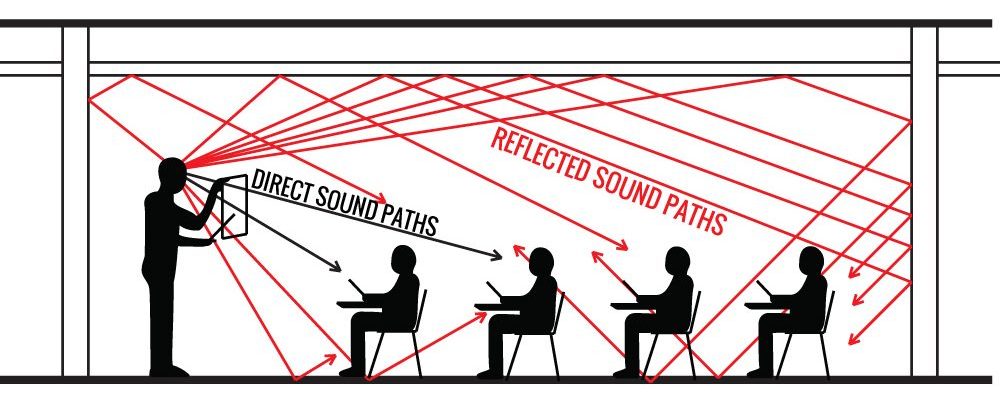
Reflecting Waves (in red) will Keep on Bouncing & Cause an Echo in this Room
As more sound waves reflect from the hard surfaces of the room, the sound loiters more in the room. The longer the sound waves stay in a room, there is more echo in that room. But eventually, the sound waves will decay in any given space at a given time.
The sound waves we perceive at different time intervals are reverberations. Thus, if there is no soft surface or absorbing surface, the reverberations in the room will cause echo. Reverberation time is the time taken by sound to decay in a room. In simple words, high Reverberation Time (RT) means more echos or noises.
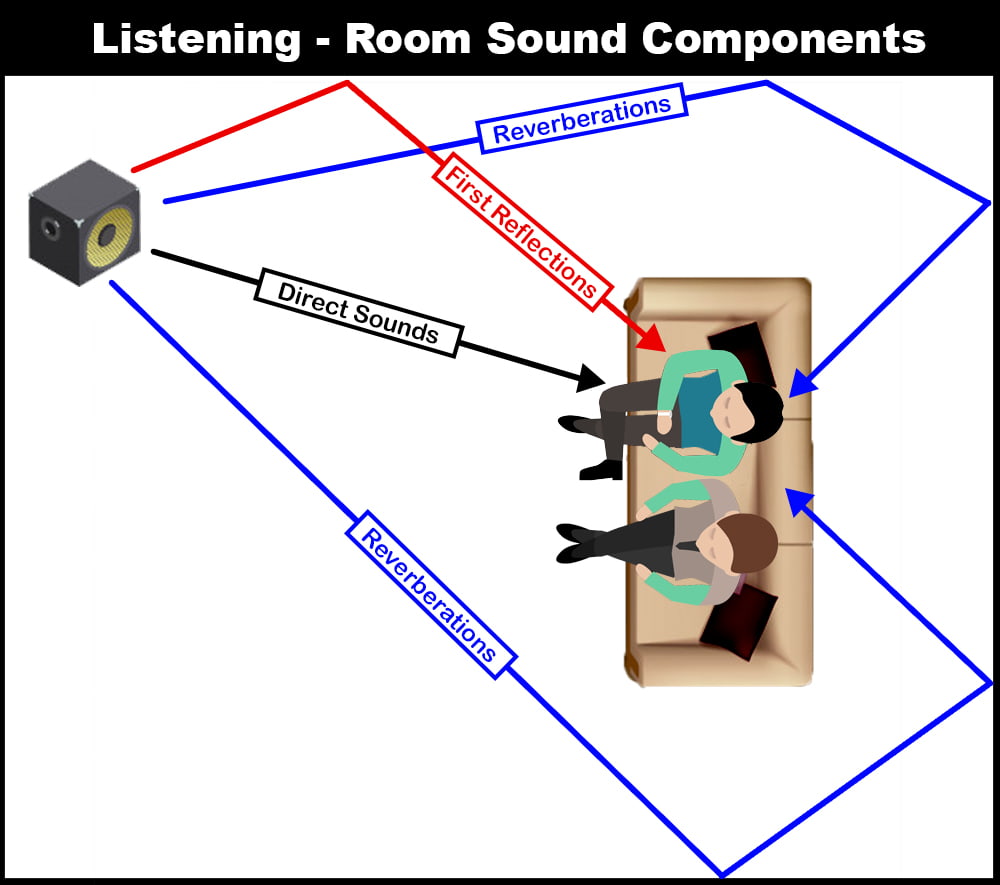
Reverberations
Acoustic panels absorb the sound waves and thus increase the rate of decay of the sound. So, acoustic surface can reduce the echo of the room and increase the clarity of the sound. This is why the position of the workstation, studio monitors, and even the acoustic panels are key factors to achieving the best room acoustics. Having monitor stands (read the reviews on best studio monitor stands) helps you finely adjust the positions of your speakers.
Every room has a different type of sound quality. If we compare the sound quality in a library and a restaurant, the library needs low RT (echo) than a restaurant. So, each space will aim different Reverberation Time (RT) value.
For home theatres or cinemas, we need Reverberation Time in range of 0.8 to 1.2 seconds.
Behaviour of Sound in the Acoustically Treated Room
For any acoustically treated space, the sound waves emitted from the source will pass through the following stages before decay. Alternatively, before reaching sound to our ears, it experiences the following:
01. Absorption – Absorption of the sound waves diminish the sound intensity.
02. Diffusion – Diffusion of sound scatter sound waves in an evenly distributed direction.
03. Reflection – Reflection of sound waves amplify the sound in a room.
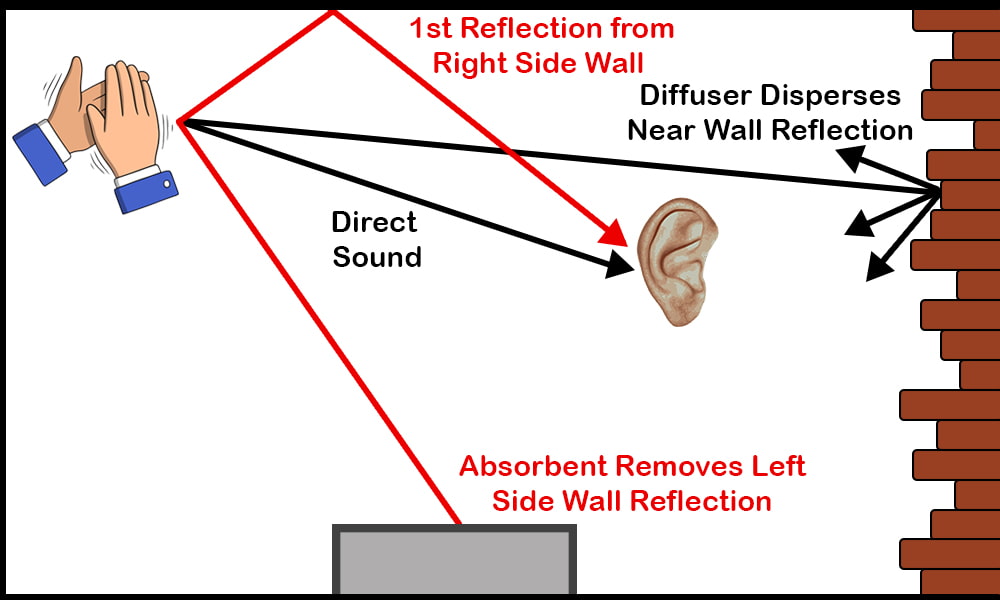
Behaviour of Sound
The acoustics surface of the room should be able to achieve the Reverberation Time of a room by balancing the absorbing, diffusion and reflection properties of sound. The acoustics panels are mainly of three types:
01. Sound absorbers
02. Reflectors
03. Diffusers
01. Sound Absorbers Panels
In an untreated room, the sound will reflect from the hard surface and reach our ears at a different time interval. In the majority of the time, we use absorptive panels to avoid the echo effect. We recommend covering 40-60% of the wall surface with absorptive panels to enhance the audio system noticeably.
NRC Value:
The acoustic panels are available in different materials, sizes, thickness, and properties. NRC (Noise Reduction Co-efficient) is a value that suggests the absorbing capacity of an acoustic panel. So, higher the value of NRC means panel has better absorbing surface. For example. If an acoustic panel has an NRC value of 0.90, it means that the panel can absorb 90% of sound and rest will reflect.
NRC value is dependent on the material, thickness and density of the panel. If the thickness is more the NRC value is more.
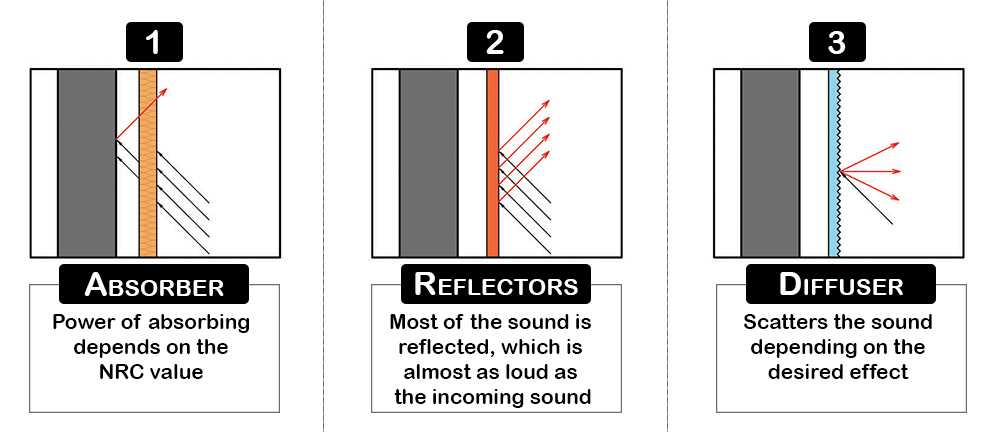
02. Reflectors
Reflectors help to amplify the sound waves. If the speaker source is away from the seat, we place at the farther end from the sound source in such a way that it reflects the sound towards the seats.
For auditoriums, the concave shape reflectors are common for the ceiling.
Generally, in home theatres, the wall at the back has a combination of reflectors and absorbers.
03. Diffusers
In the case where there are more absorptive panels in a home theatre, we suggest using diffusers. Diffusers distribute the sound waves back to space in different directions. Home Theatres that has wall-to-wall acoustic control absorption panels will undergo too much sound absorption and can results in a room that sounds “dead”. So, for such rooms, we recommend covering the panelling with 20% of the diffuser panels.
The diffusers can be of different angle, shape and depths. They scatter the sound, so there are some sound waves in the dead space.
Usually, diffusers are more commonly used in recording studios. The diffusers can be partially reflecting surface and absorptive surface.
In a home theatre, the furniture elements like chair armrest, art works, handrails, etc. act as the diffusers. So, we can neglect the use of diffusers in the home theatres.
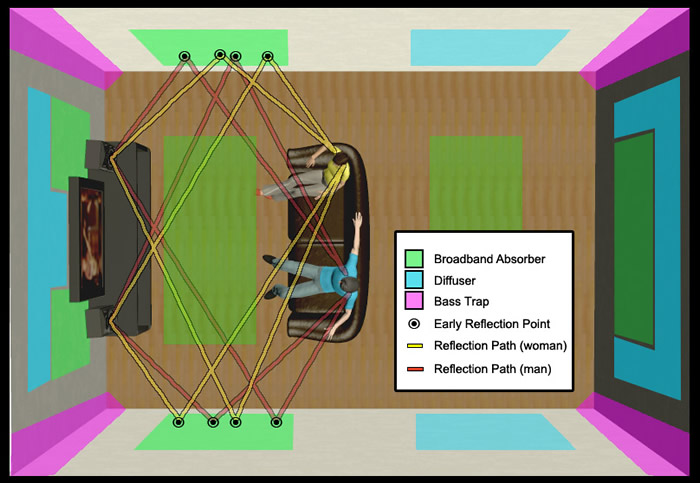
Placement of Acoustic Panels
Now, let us see the placement of acoustic panels and sound waves behaviour in a home theatre. So, here are some tips for placing an appropriate type of acoustic surface panel in the required location.
Sidewalls:
The sound from the speakers hit the first half of the wall and starts bouncing. So, this part where the sound waves first hit is called First Reflection point or Early Reflection point. So, it is necessary to put absorbers on the first reflection areas to control further echoing of sound.
Front walls:
For home theatres, we suggest covering the front wall with all absorbers. These acoustic surface panels will help to absorb the excessive sound wave from speaker to rear side of the screen. So, the front wall will have to be acoustically dead. We suggest covering the front wall and 3 feet first side wall with high NRC value boards ranging from (0.9 to 1). Such boards absorb sound by 90 to 100%.
Rear Walls:
For home theatres with a longer length, the end of the room may result with an improper sound effect. So, we recommend using diffusers. Diffusers can be of reflecting and absorbing surface. If the length of the room is sufficient for your speakers to be audible from the last seat, then we can have a series of absorber panels too.
Corner of Walls:
At the corner, there is more chance for sound waves to reflect and clog sound. So, we recommend using thicker absorbers or bass traps to absorb the sound echo. Usually, these are used in studios and high-end home theatres.
The physics of acoustics control is not simple. But we can design practically by understanding the sound behavior with such panels.
However, the sound system in any Home theatre also depends on other factors like the size of the room, the intensity of the speakers, the location of the speakers, acoustical paneling, etc.
Since home theatres are small space, there is less chance to have echoes if we use 60-70% of acoustic surface panels. One can any day hire a professional for home theatre design for their house.
Also Read:
WPC Board (Wood Plastic Composite) – Things You Need To know!!!
Gypsum Board: All You Need to Know!
Image Courtesy: Image 2, Image 6
Author Bio
Urnit Kaur – Urnit Kaur is an Architect based in Ahmedabad. She loves Design challenges and it helps her client’s to bring their thoughts into reality. She has been passionately involved in Architecture from designing projects to managing them on site since 2014. She has been part of Ahmedabad Heritage Dossier project, designing ISRO Bopal campus and currently working on other varied scale projects with Aakruti Architects. With her rich experience in fieldwork, she shares tips and facts in her blogs about Architecture, Interior and MEP services. She believes learning should never stop, so she has developed a hobby of creating colorful home décor items by experimenting different materials and aesthetics.






























